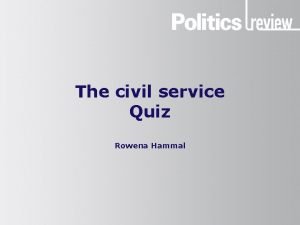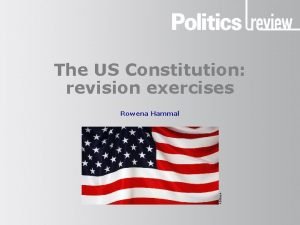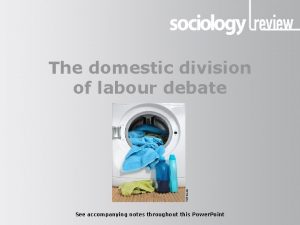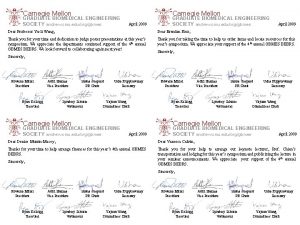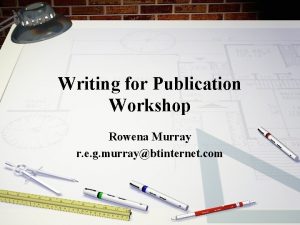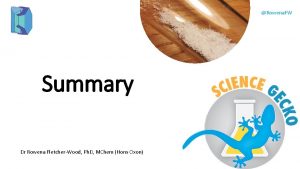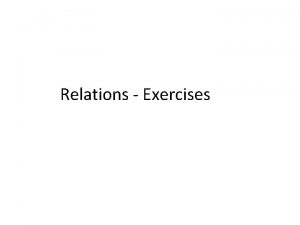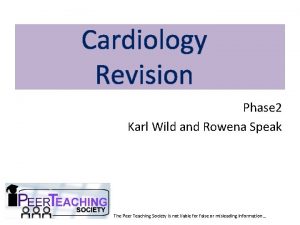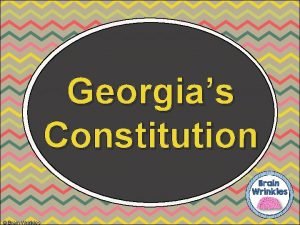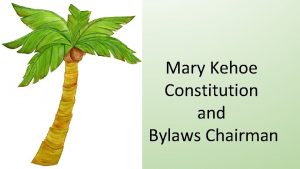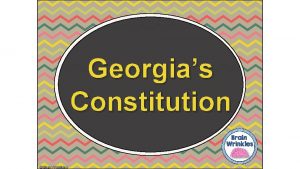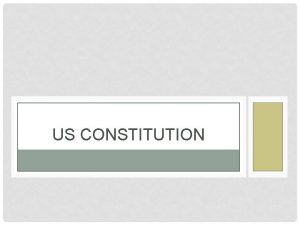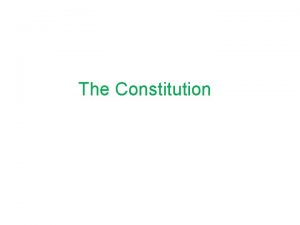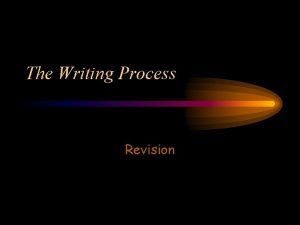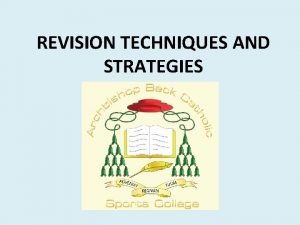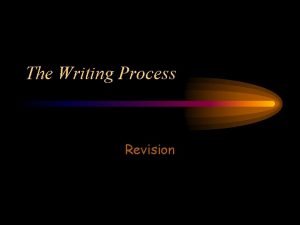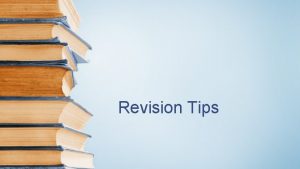The US Constitution revision exercises FOTOLIA Rowena Hammal


















- Slides: 18

The US Constitution: revision exercises FOTOLIA Rowena Hammal

The US Constitution: revision exercises How to use these revision exercises You can use these revision exercises to check your knowledge of the US Constitution. • There are five sections to work through and the correct answers are given on the slides immediately following each section. • The number of marks available for each section is written in brackets after the title. Award yourself one mark for each correct answer. There a total of 50 marks available. • Keep score as you complete each section and then add up your total score at the end to find out which US president you most resemble.

The US Constitution: revision exercises Overview (9 marks) Answer the following questions: 1. How many states are there in the USA? 2. The US has a system of government whereby there are national laws but also individual state laws. What is the name of this system? Fill in the gaps below: 3. The nature of the US Constitution allows a balance between states’ ______ and strong central _____. 4. The US executive is the _______, the US legislature is the ______ (composed of the ______ and the ________), and the US judiciary is headed by the _________.

The US Constitution: revision exercises Answers: overview 1. How many states are there in the USA? 50 (and Washington, DC, which is a federal district). 2. The US has a system of government whereby there are national laws but also individual state laws. What is the name of this system? Federal system. 3. The nature of the US Constitution allows a balance between states’ rights and strong central government. 4. The US executive is the president, the US legislature is the Congress (composed of the Senate and the House of Representatives), and the US judiciary is headed by the Supreme Court.

The US Constitution: revision exercises History of the US Constitution (9 marks) Answer the following multiple-choice questions: 1. How many British colonies were there before the War of Independence? • 9 • 11 • 13 2. What was the issue that triggered the War of Independence? • Taxation without representation • Taxation without compensation • Taxation without adjustment for inflation 3. Who was the main author of the Declaration of Independence? • George Washington • Thomas Jefferson • Abraham Lincoln Continued on the next slide…

The US Constitution: revision exercises Fill in the gaps below: 4. In 1787 the _____________ wrote the Constitution at the Philadelphia Convention. The document was a _____ that balanced the rights of small states with the demands of states with large populations. 5. The arrangements for each house of Congress were different. In the ______, states were represented equally, with ____ seats per state. 6. In the _______, states were represented according to the size of their ______, with some states receiving more seats than others.

The US Constitution: revision exercises Answers: history of the US Constitution 1. How many British colonies were there before the War of Independence? • 13 2. What was the issue that triggered the War of Independence? • Taxation without representation 3. Who was the main author of the Declaration of Independence? • Thomas Jefferson Continued on the next slide…

The US Constitution: revision exercises 4. In 1787 the Founding Fathers wrote the Constitution at the Philadelphia Convention. The document was a compromise that balanced the rights of small states with the demands of states with large populations. 5. The arrangements for each house of Congress were different. In the Senate, states were represented equally, with two seats per state. 6. In the House of Representatives, states were represented according to the size of their populations, with some states receiving more seats than others.

The US Constitution: revision exercises Key principles (8 marks) Match up each of the terms on the left to the correct description on the right. Sovereign Elected representatives make decisions on the people’s behalf. Codified Each branch of federal government has powers to constrain the other two, e. g. the president can veto legislation from Congress. Limited government Separation of powers Checks and balances The powers of the government are restricted in order to protect the rights of individual citizens and states. The Constitution is the ultimate source of authority. The Constitution relies upon the consent of the people to be governed — in return, government has an obligation to govern fairly and well on their behalf. Social contract Government is shared between the federal government and the states, with each responsible for different things. Representative government The Constitution is a written and self-contained document. Federalism The three branches of the federal government are discrete from each other. No one can be in more than one branch at the same time (exception: vice president is president of the Senate).

The US Constitution: revision exercises Answers: key principles Sovereign The Constitution is the ultimate source of authority. Codified The Constitution is a written and self-contained document. Limited government The powers of the government are restricted in order to protect the rights of individual citizens and states. Separation of powers The three branches of the federal government are discrete from each other. No one can be in more than one branch at the same time (exception: vice president is president of the Senate). Checks and balances Each branch of federal government has powers to constrain the other two, e. g. the president can veto legislation from Congress. Social contract The Constitution relies upon the consent of the people to be governed — in return, government has an obligation to govern fairly and well on their behalf. Representative government Federalism Elected representatives make decisions on the people’s behalf. Government is shared between the federal government and the states, with each responsible for different things.

The US Constitution: revision exercises Constitutional amendments (17 marks) Fill in the gaps for these important amendments to the Constitution: The Constitution is designed to be difficult to amend. In order for Congress to propose an amendment, a ______ majority is needed in both houses, and ______ of the state legislatures must ratify it. These types of majorities are known as ____-majorities because they are greater than a simple majority of 50%+1. The first ten amendments to the Constitution are called the ________ and contain fundamental constitutional rights. These include the 1 st Amendment which is the right to freedom of ____, the 2 nd Amendment which is the right to bear ____, the 4 th Amendment which protects citizens against unreasonable _____, the 5 th Amendment which gives rights to people accused of a ______, the 8 th Amendment which prohibits cruel and unusual _______, and the 10 th Amendment which specifies the powers reserved for the _______ and the people. Continued on the next slide…

The US Constitution: revision exercises Answer the following questions: 1. How many amendments to the Constitution are there? 2. Which amendment is often cited by defendants in trials who refuse to answer questions (known as ‘taking the ____’)? 3. Which amendment is used by campaigners to justify the abolition of capital punishment? 4. Which amendment is beloved by the National Rifle Association (NRA)? 5. The 13 th, 14 th and 15 th amendments were all ratified after the Civil War. What was their purpose? 6. The 21 st Amendment of 1933 repealed the 18 th Amendment of 1919. What failed experiment did this end? 7. Why might women be encouraged by the 19 th Amendment but disheartened by the Equal Rights Amendment (ERA)?

The US Constitution: revision exercises Answers: constitutional amendments The Constitution is designed to be difficult to amend. In order for Congress to propose an amendment, a two-thirds majority is needed in both houses, and threequarters of the state legislatures must ratify it. These types of majorities are known as super-majorities because they are greater than a simple majority of 50%+1. The first ten amendments to the Constitution are called the Bill of Rights and contain fundamental constitutional rights. These include the 1 st Amendment which is the right to freedom of religion, speech, press, and assembly, the 2 nd Amendment which is the right to bear arms, the 4 th Amendment which protects citizens against unreasonable seizures and searches, the 5 th Amendment which gives rights to people accused of a crime, the 8 th Amendment which prohibits cruel and unusual punishments, and the 10 th Amendment which specifies the powers reserved for the states and the people. Continued on the next slide…

The US Constitution: revision exercises 1. How many amendments to the Constitution are there? 27 2. Which amendment is often cited by defendants in trials who refuse to answer questions (known as ‘taking the ____’)? 5 th 3. Which amendment is used by campaigners to justify the abolition of capital punishment? 8 th 4. Which amendment is beloved by the National Rifle Association (NRA)? 2 nd 5. The 13 th, 14 th and 15 th amendments were all ratified after the Civil War. What was their purpose? To abolish slavery and confer rights upon ex-slaves 6. The 21 st Amendment of 1933 repealed the 18 th Amendment of 1919. What failed experiment did this end? The prohibition of alcohol 7. Why might women be encouraged by the 19 th Amendment but disheartened by the Equal Rights Amendment (ERA)? The 19 th enfranchised women. The ERA was passed by Congress in 1972 but failed to be ratified by two-thirds of states by its 1982 deadline, so was not adopted

The US Constitution: revision exercises Federalism (7 marks) Match up the phases of federalism on the left to the correct description on the right. Dual federalism (1780 s– 1930 s) States are allowed more choice over how they spend federal money, through the use of block grants. 14 th Amendment Federal government may charge income tax. (1868) Affordable Care Act made health insurance compulsory, regardless of state laws. 16 th Amendment (1913) Co-operative federalism (1930 s– 60 s) New federalism (1970 s onwards) George W. Bush (2001– 09) Barack Obama (2009–) Greater role for federal government, first through the New Deal and later through categorical grants. States have to ensure citizens have equal protection under the law — this provided the legal basis for the ending of segregation in the South. Massive increase in federal spending to fund wars, counterterrorism and education. Federal government and state had different functions. In order to protect states’ rights, federal government had a limited role.

The US Constitution: revision exercises Answers: federalism Dual federalism (1780 s– 1930 s) 14 th Amendment (1868) 16 th Amendment (1913) Co-operative federalism (1930 s– 60 s) New federalism (1970 s onwards) George W. Bush (2001– 09) Barack Obama (2009–) Federal government and state had different functions. In order to protect states’ rights, federal government had a limited role. States have to ensure citizens have equal protection under the law — this provided the legal basis for the ending of segregation in the South. Federal government may charge income tax. Greater role for federal government, first through the New Deal and later through categorical grants. States are allowed more choice over how they spend federal money, through the use of block grants. Massive increase in federal spending to fund wars, counter -terrorism and education. Affordable Care Act made health insurance compulsory, regardless of state laws.

The US Constitution: revision exercises Which president are you? Add up your total score to find out which US president you most resemble. 41– 50 George Washington. The ‘father of the nation’who won the War of Independence and presided over the newly founded USA, earning himself a special place in the history books. Clearly revision is proceeding well and you are headed for greatness. Keep going! 31– 40 Barack Obama. The jury is still out on this president. Obama promised change and a new kind of politics but his tenure has been hampered by partisanship and a struggling economy. Like him, you have the potential to succeed but you’ve got a lot more work to do. Yes, you can! Continued on the next slide…

The US Constitution: revision exercises 21– 30 Jimmy Carter. The likeable peanut farmer from Georgia was widely perceived as well-meaning but ineffective, and was refused a second term by the electorate. Time to hit the books to ensure that you don’t suffer a similarly frustrating fate. Get cracking! 11– 20 Herbert Hoover presided over the Wall Street Crash and the Great Depression, and was kicked out of office by voters after just one term. Your exam result could be equally depressing if you don’t improve your knowledge base. It’s time to emulate Franklin D. Roosevelt and make a New Deal with your revision! 0– 10 William Henry Harrison. Sadly this president died of pneumonia in 1841, after only 32 days in office. Your exam could be less successful than Harrison’s presidency unless you do some revision. Don’t make excuses — start learning now!
 Rowena hammal
Rowena hammal Lesson 1 principles of the constitution
Lesson 1 principles of the constitution Texas constitution vs us constitution
Texas constitution vs us constitution Nc constitution vs us constitution
Nc constitution vs us constitution Constitution what is constitution
Constitution what is constitution Apops fotolia
Apops fotolia Entgeltsysteme arten
Entgeltsysteme arten Us constitution
Us constitution Fotolia llc
Fotolia llc Fotolia
Fotolia Passive sentence
Passive sentence Rowena bergmans
Rowena bergmans Rowena schoo
Rowena schoo Rowena neville
Rowena neville Rowena mittal
Rowena mittal Rowena murray
Rowena murray Rowena california gambling
Rowena california gambling Quá trình desamine hóa có thể tạo ra
Quá trình desamine hóa có thể tạo ra ưu thế lai là gì
ưu thế lai là gì
